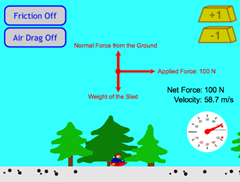 Rocket Sledder
Rocket Sledder
Resource:
Physics Interactives - Rocket Sledder
Rocket Sledder Activity
Grade Level: High School
Description:
This simulation promotes understanding of net force as students explore friction and drag forces on a horizontally-moving rocket sled. Learners can change the weight of the sled and move a slider to control the thrust. Friction and air resistance can be turned on or off to highlight the effects of these forces on the motion. At all times, an animated free-body diagram shows the interacting forces. Track your speed with the built-in velocimeter and watch the changes in net force as the velocity, weight, thrust, friction, and air resistance is changed.
Performance Expectation:
Force and Motion (HS-PS2-1): Analyze data to support the claim that Newton’s Second Law of Motion describes the mathematical relationship among the net force on a macroscopic object, its mass, and its acceleration.
This activity aligns with the three dimensions of the Next Generation Science Standards in the manner described below:
| Force and Motion (HS-PS2.A.1) Newton’s Second Law accurately predicts changes in the motion of macroscopic objects. |
Learners will visualize how an unbalanced force causes an acceleration and build understanding that acceleration is directly related to net force and inversely related to the mass of the object. The package is designed to promote conceptual understanding and introduces very little mathematics. |
| Cause and Effect: Cause and effect relationships can be suggested and predicted for natural and designed systems by examining what is known about smaller-scale mechanisms within the system. |
The Rocket Sled is a system that includes the sled and rider, the ground, and the air. This package reinforces understanding of how components of a system interact to affect motion. It lays a foundation for understanding the mathematical representations of Newton’s Second Law and will help students see how frictional forces and air resistance affect the value of net force. |
| Developing and Using Models: Develop and use a model based on evidence to illustrate the relationships between systems or between components of a system. |
This simulation-based package gives students a robust way to model how motion is affected by the interactions in a rocket sled system. The system consists of: sled & rider, ground, and air. Change the weight of the sled, add friction to the ground, or add drag to the air. It lays a foundation for understanding the mathematical representations of Newton’s Second Law and will help students see how frictional forces and air resistance affect the value of net force. |
| Constructing Explanations: Apply scientific principles and evidence to provide an explanation of phenomena and solve design problems. |
In the accompanying Exercise, students respond to qualitative questions that probe the directon of the forces and the changes in the state of motion. It is an effective Exercise in helping students recognize how the direction of the net force is associated with changes in the object's velocity (speeding up and slowing down). They also draw force diagrams to demonstrate their mastery of how motion is affected by resistive forces (friction and drag). |
Associated Reading from The Physics Classroom
Other Supporting Pages at The Physics Classroom:
Search the NGSS Corner
Maybe you're looking for something really specific that pertains to a desired topic and emphasizes one or more of the listed NGSS dimensions. Why not try a search of this section of our website? Simply select from one or more of the pull-down menus and click Search. This page will reload and a collection of possibilities will be displayed in this section of the page and sorted by relevancy.